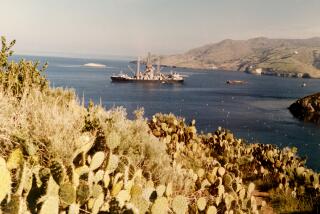Soviet Secrets: Subs, Germs and Dolphins
- Share via
“Inside the Soviet Military Machine,” a three-part series that begins tonight on the History Channel, provides an explanation from a Russian Parliament member for the decision by the Soviet Union to produce a massive amount of killer germs despite a 1972 treaty with the U.S. to ban biological warfare.
“The logic was very simple,” says Alexei Arbatov, an arms control expert. “The other side has it or may have it, so we have to have it. And preferably more.”
While his explanation is specific to anthrax, bubonic plague and 50 other biological horrors that the Soviets “weapon-ized” in mind-boggling quantities, it just as easily provides the overall rationale that fueled both sides of the Cold War arms race: They have it and so we need it.
With top-notch reporting and succinct narration by veteran reporter Morton Dean, “Inside” provides a fascinating look at three Soviet military programs meant to compete with similar efforts in the U.S.: construction of nuclear-powered submarines, development of germ warfare, and use of dolphins to thwart saboteurs.
Tonight’s installment details the Soviets’ desperate attempt to catch the U.S. in the construction of submarines. With the launching of the Nautilus, the first nuclear-powered sub, and then the Washington, the first sub capable of launching ballistic missiles, the Soviets were frantic.
“They were convinced the imperialists were trying to encircle them and prepare for war,” says Dean.
In their rush, the Soviets skipped prototypes and scrimped on safety. The result was the 1961 catastrophe aboard the K-19 (which is now the story line of a movie, opening this week, starring Harrison Ford as the Soviet submarine captain).
A malfunction and fire in the reactor threatened to sink the boat and spread radiation into the water off northern Europe. Only the bravery of the crew, led by a young lieutenant, Boris Korchilov, allowed the sub to stabilize.
The captain, unfairly, was made a pariah within the military establishment. The 14 dead were buried in lead-lined coffins and no public mention was made of the tragedy. “The image of an all-powerful Soviet Union had to be maintained and all deficiencies hidden,” Dean notes.
Of the three parts, the scariest is Wednesday’s look at the Soviets’ “toxic archipelago,” a germ-producing empire that proliferated despite a 1972 anti-germ warfare treaty. The Soviets were convinced that President Nixon was lying when he promised to dismantle the U.S. germ capability.
With the crumbling of the Soviet Union, the germ plants are now in ruins, and the U.S. is part of a program to round up the lethal stockpile and offer employment to the germ scientists to keep them from selling their expertise to a rogue nation or terrorist group.
But a U.S. germ expert, Amy Smithson, doubts the program’s effectiveness. Smithson says the U.S. is putting only “chump change” into the effort. Germ scientists are driving cabs and selling fruit in the nearly-liberated republics.
The final installment, “Dolphin Soldiers,” tells of the Soviets’ attempt to train dolphins to detect and, in one farfetched plan, capture enemy saboteurs.
The Soviets were convinced the CIA caused the sinking of a Soviet battleship in 1955 with the loss of 608 sailors.
In the frenzy and fear of the Cold War, not even Flipper had a deferment.
*
“Inside the Soviet Military Machine” begins tonight at 9 on the History Channel and continues through Thursday. The network has rated it TV-G (suitable for all ages).
More to Read
Sign up for Essential California
The most important California stories and recommendations in your inbox every morning.
You may occasionally receive promotional content from the Los Angeles Times.













